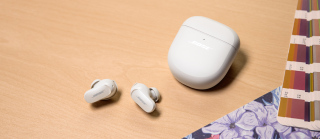Share This:
Everyone’s ears are unique, but how your headphones and earbuds deliver sound has always been the same – until now. CustomTune technology, a ground-breaking innovation from Bose, personalises sound and noise cancellation to everyone’s ears. The result? The world’s best noise cancellation and richer, more immersive sound.
For decades, headphones and earbuds across the audio industry were designed to ensure an acceptable listening experience for all listeners.
The one-size-fits all approach didn’t always guarantee the best performance. Why? Because all ears are different – and those differences affect the sound we hear and the noise cancellation.
“Everyone’s ear canals are unique, causing them to behave differently acoustically”, says John Rule, PhD, an aerospace engineer, and senior systems engineer at Bose. “By building headphones to fit all ears, we were limiting performance.”
Rule had an idea. What if Bose could improve the performance of headphones and earbuds by tailoring the sound and noise cancellation to each person’s ears? He told his boss he had an idea for personalisation and asked for time and space to work on the problem.
Six months later, Rule had realised the vision of personalised noise cancellation. Other engineers used his core idea to figure out a way to offer personalised sound. Together, the innovations became CustomTune sound calibration technology. It launched in our noise cancelling earbuds, the Bose QuietComfort Earbuds II.
When you first put QuietComfort Earbuds II in your ears, they send out a welcome chime – a thwomp sound effect. That chime travels through your ear canals and bounces back to the earbuds, where it’s picked up by microphones. That’s where CustomTune works its magic.
The technology uses complex algorithms and mathematics to understand how the chime is changed by the size, shape and depth of your ears. For example, the architecture of your ears may amplify some pitches while muffling others. CustomTune neutralises the changes your ears have on the sound. This ensures the sound is as close to the original recording as possible.
Like sound, the outside noise – and the noise cancelling waves the earbuds use to cancel them – are changed as they travel through your ear canals. CustomTune measures those changes caused by the shape of your ears and then compensates for them. This results in a much quieter experience. It also softens sounds that are hardest to reduce, like voices.
When Rule and other Bose engineers evaluated CustomTune’s ability to block out noise, they were blown away. QuietComfort Earbuds II earbuds cancelled noise from the outside world better than any noise cancellation earbuds or over-ear headphones on the market.
“Why does this matter? Without powerful noise cancellation, you’re forced to turn up the volume so high it becomes uncomfortable to listen”, explains Rule. “QuietComfort Earbuds II remove almost all the outside noise, allowing your music to play into that nice quiet space.”
How does personalised audio affect the sound of your music? Most artists create music using a sophisticated audio system within a sound studio. When music is played in your ears through headphones or earbuds, the architecture of your ear canals changes the music from its original recording. Some frequencies are emphasised while others are de-emphasised.
Reflecting on the discovery of CustomTune, Rule points out that new ideas rarely come out of nowhere. Innovation happens when individuals or teams apply their expertise in one field to solve a problem in another. It took a rocket scientist to invent personalised audio.
“I’ve worked in lots of different research fields, from acoustics and fuel cells to defence technology and high-powered lasers”, says Rule. “The Eureka moment for CustomTune came when I applied a maths technique from my aerospace background to this acoustics problem.”
Is there something about Bose that promoted the discovery? Rule says that Bose’s culture of innovation allowed him several months to work on a project with no guarantee of success.
“Amar Bose, the company’s founder, believed the company should always have a team of smart people doing research that isn’t tied to product development. Their goal? To discover better stuff. Later, we can figure out how to turn new discoveries into great products. If you have a great idea at Bose, you’re encouraged to pursue it – and that’s exactly what I did.”







